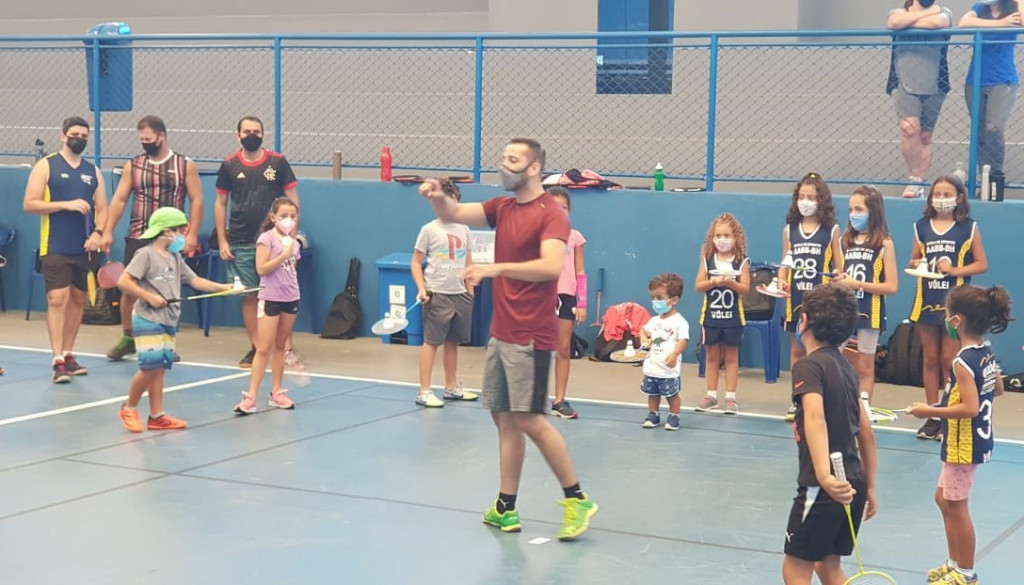This is the 33nd story in our Humans of Shuttle Time series, in which we present the perspectives of those who work on badminton development at the grassroots level. Daiverson Ferrari Rodrigues, Shuttle Time Tutor of Brazil Badminton Federation, speaks about his experiences while developing badminton at the local and national level in his country.
Childhood Days
From an early age I was active in sports. At the age of 11, I started training in volleyball and soccer, competing in school and regional amateur competitions. I was a child with separated parents, so volleyball and soccer kept me active in school while my mother worked.
Tryst with Badminton
In 2004, I met a professor at college who was conducting badminton sessions. I joined as an intern and began to explore it by watching videos and networking with players from other states. By 2008, badminton had become my main activity.
I started understanding the culture behind the sport and perceived it as a potential tool for personal and social development.

Daiverson Ferrari Rodrigues at a coaching session.
In 2008 I started my badminton school in partnership with a club in Juiz de Fora. We started training and competitions. In 2013, I took the technical certification course conducted by the Brazilian Badminton Federation. I started a social project in Linhares, the neighborhood where I was born. We started the Badminton Sports Federation of Minas Gerais, since the state did not have an active federation. From then on, I moved away from the courts as a coach to assume the role of manager of the federation. However, I did my coaching levels, and I became Shuttle Time Tutor in 2020.
Memorable Moments
The state and national competitions allowed me to meet experienced coaches who helped me in my development. The training courses gave me access to international coaches. Working at the Pan American Games in Rio de Janeiro in 2007 was a unique experience. I was able to interact with several athletes from various countries. I am currently one of the coaches who participates in the High Performance Sports Course held by the Brazilian Olympic Committee through the Brazilian Association of Coaches. Through the course I was able to meet renowned coaches and scholars of the sport, as well as renowned coaches of badminton in Brazil.
What Badminton Means
Badminton provides inclusive practice, enabling the emergence of new talent and providing children and young people access to new environments, new people and new cultures.
What Makes Badminton Different
The ease of success during practice, the possibility of playing with people of different ages and gender and social backgrounds, the possibility of playing as a family. When played recreationally, the low risk of injury is another attraction.
The possibility of equality and inclusion through Para badminton. The dynamics of the game, its speed, cognitive requirement, the principles or fair play existing in the sport. All this makes badminton special.
Developing Badminton in the Community
Initially the promotion was done through presentations in schools, clubs, squares, courts and public places. Developing the sport through the training of teachers, who are multipliers of knowledge, is a unique experience.
Impact of Shuttle Time
Shuttle Time has become a tool that allows teachers to transmit a methodology capable of introducing badminton effectively, with regard to motor, cognitive and social aspects. In addition, it allows students a positive experience with the sport, awakening them to the possibility of using it for systematic practice, and increasing the number of practitioners.
Lessons from Shuttle Time
The biggest lesson I have learnt working with Shuttle Time is that our purpose is always related to people. Initially my purpose was to spread the word about badminton. After starting Shuttle Time as a tutor, I understood that the purpose is to impact people’s lives, give them a positive experience, develop physical, motor and cognitive abilities, as well as personal development.
Previous Stories in This Series
Humans of Shuttle Time: Ammar Awad
Humans of Shuttle Time: Carolin Ruth
Humans of Shuttle Time: Caroline Brial
Humans of Shuttle Time: Danny Ten
Humans of Shuttle Time: Mohlala Mopeli
Humans of Shuttle Time: Tatiana Petrova
Humans of Shuttle Time: Levente Nagy-Szabó
Humans of Shuttle Time: Kumon Tarawa
Humans of Shuttle Time: Didier Nourry
Humans of Shuttle Time: Joseph Devenecia
Humans of Shuttle Time: Su Ying Lau
Humans of Shuttle Time: Erin Walklate
Humans of Shuttle Time: Bukasa Mukoma Marcel
Humans of Shuttle Time: Luis Fernando Montilla
Humans of Shuttle Time: Artur Niyazov
Humans of Shuttle Time: Galkhuu Zulbaatar
Humans of Shuttle Time: Zuzana Rajdugova
Humans of Shuttle Time: Milan Barbir
Humans of Shuttle Time: Nargis Nabieva
Humans of Shuttle Time: Hannes Andersson
Humans of Shuttle Time: Merlie Tolentino
Humans of Shuttle Time: Nikhil Chandra Dhar
Humans of Shuttle Time: Geoffrey Shigoli
Humans of Shuttle Time: Erik Betancourt Luna
Humans of Shuttle Time: Richard Ssali Kaggwa
Humans of Shuttle Time: Azizbek Madjitov
Humans of Shuttle Time: Elie Jean
Humans of Shuttle Time: Danielle Whiteside
Humans of Shuttle Time: Oscar Alejandro Vera Suarez































